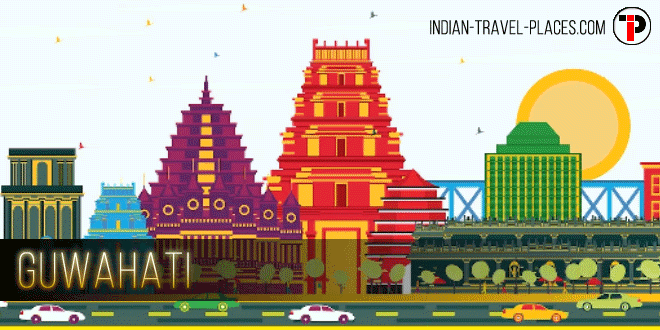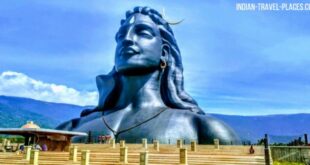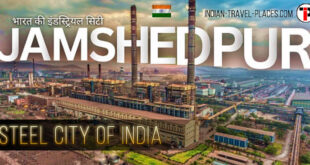Guwahati is a sprawling city beside the Brahmaputra River in the northeast Indian state of Assam. It’s known for holy sites like the hilltop Kamakhya Temple, featuring shrines to the Hindu deities Shiva and Vishnu. To the east, 18th-century Navagraha Temple is an astronomical center with planetary shrines. Umananda Temple, dedicated to Shiva and covered with engravings, stands on Peacock Island in the river.
| Name: | Guwahati |
| Location: | Kamrup District, Assam |
| Climate: | Summers: 35° C (Max), 25° C (Min) | Winters: 20° C (Max), 10° C (Min) |
| Best Time To Visit: | October to April |
| Nearest Airport: | Lokpriya Gopinath Bordoloi International Airport – Borjhar, Guwahati, Assam 781015 |
| Railway Station: | Guwahati Junction Railway Station |
| Must Visits: | Uma Nanda Temple, Janardana Temple, Ugro Tara Temple, Assam State Museum, Kamakhya Temple and Pan Bazaar |
| Language Spoken: | Assamese, Hindi & English |
| STD Code: | 0361 |
Guwahati is one of the major cities of Eastern India. It comes under the administrative district of Kamrup in the Indian state of Assam. Sprawling over an area of 556 square kilometers, this city is the largest city of northeast region and one of the largest cities of India. Thus, it is often referred to as “The Gateway of the North-East“. Even the state capital, Dispur is a part of this city. Sited at an elevation of 55 m above the sea level, Guwahati has a subtropical climate with light summers (April – May), pleasant winters (October-March) and moderate monsoons (June-September) with an annual precipitation of 1613 mm. It is sited on the southern banks of swiftly flowing Brahmaputra River and the foothills of the Shillong plateau, the combination of which makes the place naturally beautiful.
The name Guwahati has been derived from Assamese words, “Guwa” meaning Areca nut and “Haat” meaning market place, which when combined form Guwahati. However, in earlier time, it was known as “Pragiyotishpura” literally meaning “The Light of East”. This city’s earlier history is unclear, but the evidences of its existence can be traced back to the epics, puranas and other traditional histories. Guwahati has a complex history which dates back to the 6th century AD, when it was the capital of the Varman and the Pala dynasties of the Kamarupa kingdom. But after the destruction of them in 12-15 century AD, it became a strategic colony of the Koch Hajo and Ahom Kingdoms of western and eastern Assam. Due to its existence in many ancient epics and puranas, this city is believed to be one of the oldest cities of Asia.
The city is also a major center for cultural and sports activities in the northeastern region and for the administrative and political activities of Assam. The city is also an important hub for transportation in the northeast region. The main factors of its economy are tourism, recreation, education, research and cultural activities. Guwahati, with its ancient roots, offers an abundance of archeological sites, historical monuments, educative museums and various religious places. Some of the tourist attractions of Guwahati are Uma Nanda Temple, Janardana Temple, Ugro Tara Temple, Assam State Museum, Guwahati Planetarium, Navagraha Temple (Chitrasal Hill), Kamakhya Temple, Bhubaneswari Temple, Basistha Ashram. When in Guwahati, don’t miss a chance to lay your hands on the authentic handicrafts and artifacts as souvenirs from the shopping arcades like G.S. Road, Pan Bazaar and Fancy Bazaar.
Best Time To Visit Guwahati
Set amidst green hilly terrains and skirted by rolling hills, Guwahati, the capital city of Assam has etched a unique status for itself in the country’s map. Popularly deemed as the gateway of the northeast, this old city has evolved immensely over the past few years to become the hub of northeastern India. Posing as an impressive blend of colonial past and cosmopolitan culture, the city of Guwahati is truly a microcosm of indigenous tribes, entities, ethnicities and beliefs. The historical sites that dots the city takes you down across the pages of history and reveals the indelible impression that the earlier kings and dynasties engraved on this part of the land. A charming city gifted with lovely weather, friendly people and stunning food, a visit to Guwahati is truly an experience in itself. Adding to the glitz and glamour of the city is its shopping lanes that add to the thrill of any tourist visiting Guwahati. The regional specialties like handlooms, artifacts and other local items are a must-buy here. To explore more about the attractions of Guwahati, do hit the city during the right season of the year. Read the article below to find more information on best time to visit Guwahati.
When To Go To Guwahati
Season:
Situated on the banks of the mighty River Brahmaputra, Guwahati enjoys the bliss of all three seasons. The summer season, extending from March to June, is usually smoldering hot with temperature ranging from 22° C to 38° C. If you visit the place during summer, then do pack in enough light cotton clothes to avoid discomfort. The monsoons, lasting from July to August, brings relief from the blazing summers. Although the rampant showers bring life to the verdancies of the city, intense rainfall can at times leads to swamp and heavy deluge. During this time, the temperature remains moderate adding to the blissful ambiance of the city. Monsoon is followed by chilling days of winter, with temperature oscillating between 12° C to 27° C. The winters here are characterized by misty and foggy mornings and sporadic showers that adds to the winter chill of the place.
Best Time To Explore Guwahati:
Although the weather here remains agreeable all throughout the year, to experience the best of the city, visit the place anytime between October to April. The scanty rainfall, moderate temperature, and other pleasant weather conditions makes the region look even more beautiful. Adding to the loveliness of the nature is the buoyant celebrations of the city that gives you a sneak-peek into the customs and traditions of Assam. The major festival the place – Bihu is celebrated with great pomp and joy and the customary Bihu dance just add to the spirit of the jubilation.
Things To Do:
Being the major tourist hub of north-east India, Guwahati attracts huge number of tourists from around the world. Fed up with the hustle and bustle of city life, if you want to freshen up your mind, then Guwahati is the place to go. With a number of attractions to explore, you are likely to be bewildered when planning your itinerary here. From temples to monuments and from natural serene to archeological sites, you can choose from a host of interesting places. Some of the noted attractions of the city are Kamakhya Temple, Assam State Zoo, Sri Purva Tirupati Balaji Temple and Nabagraha Temple. Adding to this are the shopping destinations in the city that allures you with its artistic bucolic attractions that are renowned all over the world. Like any other places, the journey to Guwahati is incomplete without exploring the authentic taste of Assamese cuisine such as ‘pabho fish’, ‘fish tenga’ sand other non spicy affair.
History
Fondly dubbed as the gateway of the northeast, the importance of the age-old city of Guwahati can be in no way undermined. The origin of Guwahati still remains ambiguous with several myths surrounding its existence. Guwahati, meaning ‘areca nut marketplace’ in Assamese, was known by the name of ‘Gauhati’ during the British Raj. The Ambari disinter in the city shed lights on the different dynasties that ruled the place, economic progress and military strategy that existed during that era. Guwahati was ruled by the Varman Empire before it was passed on to the Pala reign belonging to the Kamarupa monarchy. In the medieval period, the city changed hands with the Kamata Kingdom before the rise of the Ahom dynasty. The rise of the Ahom rulers saw several combats with the mighty Mughal leaders. Despite of several attempts, the Muslim invaders were unable to capture the port city. Later, the British troops were left with no other option but to intervene in the internal affairs of the state of Assam and safeguard the continent from being invaded by Burma. Read the write-up to know more about the history of Guwahati.
Guwahati History
Early Years:
The fables associated with the existence of Guwahati goes back to the mythological era. Even though there are no concrete proof available to testify the origins of the city, it cannot be denied that the city has found mention in the puranas, epics and other important texts. A detailed archeological study have confirmed that the place was once ruled by king Naraka and Bhagadatta. The Goddess Kamakhya temple seated in Nilachal Hill, the beautiful astrological shrine Navagraha situated in Chitrachal Hill, and the archaeological remnants in Basista are believed to date back to the ancient fictive period.
Hindu Kingdoms:
The Ambari exhume has been significant to archeologist as it enlighten us on the past dynasties and kingdoms. Starting from the 6th century AD, the town was referred as Pragjyotishpura, which deciphers as the ‘light of the east’. The region became an important center under the Pala and Varman reign, who were believe to be a part of the Kamarupa Kingdom. Xuanzang a Chinese traveler describes the city as one of the most prosperous province during the 7th century AD. As per his description, the place was under the Varman King Bhaskaravarma, who developed a strong navy base in the region and a flourishing trading centre. After the collapse of the Pala dynasty, Guwahati saw the rise of the Kamata Kingdom. Kamata Kings ruled the place from the 12th to the 15th century. With the rise of the Ahom Empire, the place lost its significance as a commercial trading post and mainly became a military hub.
Mughal Rule:
By the start of the 16th century, the sub-continent was dominated by the forces of the Mughal emperors. There were certain regions in the country that the Muslim leaders were unable to capture, despite their constant efforts, Guwahati being one of those lands. Under the able commander general Bir Lachit Borphukan of the Ahom kingdom, the Battle of Saraighat took place within the vicinity of Guwahati in 1671. Historians describe Bir Lachit Borphukan as a heroic figure in the history of Guwahati, because it was under his expertise in warfare that the Ahom army was able to defeat the outsized and powerful military forces of the Mughal seventeen times.
British Raj:
By the year 1826, the lower half of the state of Assam was under the British rule. By 1906, the place became a part of British India. At the outset, the state of Assam including the city Guwahati merged with the Bengal Presidency. Later in the year of 1906, the city was referred as an important part of eastern Bengal in Assam. After independence, Assam’s capital shifted from Shillong to Dispur, which is currently the administrative hub of Guwahati.
How To Reach
Earlier known as Pragjyotishpur, the current-day capital city of Assam, Guwahati have indeed come a long way. Said to have been built by the demon king Narakasura and home to Hindu god of love, Kamdeva, Guwahati has scores of mythical lores tagged to its name. The sleepy capital of Assam, Guwahati, meaning ‘market of areca nut’, has risen to become an important tourist hub today. Clubbed amidst the picturesque hills of the Himalayan mountain range and the gushing Brahmaputra River, the beautiful city of Guwahati truly spells bliss. Since its formation in the 6th century, the city has been subjected to warfare and insurgency. Nevertheless, despite of all the upheavals, the charm of Guwahati has remained unsullied. Deemed as the gateway to the other northeastern states of Mizoram, Manipur, Tripura, Meghalaya, Sikkim and Arunachal Pradesh, Guwahati serves as an important link point for the tourists. The city is endowed with an impressive transport system and boasts of well connected roads. To know more about transport system of Guwahati and how to reach the city, read on.
Traveling To Guwahati
By Air:
Guwahati is connected to all the major cities within and outside the state by airways. The major airport of Guwahati, Gopinath Bordoloi Airport is located at 23km away from the city. It provides air services on a regular basis and also acts as a base for the Indian air force. Guwahati is connected by air to the major cities of India like Delhi, Kolkata, Imphal, Agartala, Aizawl, Dibrugarh and Jorhat. Regular flight services to the city of Guwahati are available from Delhi and Kolkata. Indian airlines and most of the other private airlines like Pawan Hans helicopter service, Indigo Airlines, Spice Jet, Jet Airways, Kingfisher Airlines, JetLite etc. operate from this airport.
By Rail:
Indian railway has been a major means of transport facilities to Guwahati. The Paltan Bazaar Railway Station, which is one of the major terminus on the North-East Frontier Railway, is placed on the western side of Guwahati and links the city to all the major cities of India. A number of trains operate regularly to the cities of Delhi, Kolkata, Chennai, Bangalore, Bhubaneswar, Mumbai, Kochi and new Jalpaiguri. The famous Rajdhani Express provides regular service to and from Delhi.
By Road:
The Assam State Transport Corporation not only connects the different towns within the state but also the neighboring states like Meghalaya, Mizoram, Manipur, Arunachal Pradesh, etc. The ASTC offers regular and luxury bus services at a very reasonable rate. The Assam State Transport company buses link Guwahati to Kaziranga, Tezpur, Jorhat, Sibsagar and Silchar. The ISBT bus station in Guwahati is an important terminus for the northeastern region.
By Water:
Being located on the banks of the mighty Brahmaputra, the Assam State Transport Corporation provides ferry services for the tourists to travel across the Brahmaputra River at nominal rates. Water service has proved to be very valuable for the people of Assam. In fact, for some parts of the state this is the only mode of transportation. A number of ferries operate regularly from here.
Getting Around:
Apart from these transport facilities, Guwahati also have tourist taxis, auto rickshaws and cycle rickshaws that can be used to commute anywhere within the city and are safe and relatively inexpensive.
Places To See
Guwahati, the light of the East, is adorned with sprawling tea gardens, fertile meadows and picturesque attractions. The right mix of perfect climate, mouth-watering Assamese cuisine and friendly people makes Guwahati one of the most preferred tourism spots in India. The mighty Brahmaputra River flowing all the way from Tibet is inseparable from Guwahati and undoubtedly remains one of the major highlights of the land. The ideal time to hit this quaint town is from October to April when the weather is pleasant. Unlike the other over-hyped tourism spots, Guwahati stays happily unadulterated and seems to be at ease with what it is. The shopping markets stretched over Guwahati however, tend to get a bit rackety with all the tourists and local inhabitants jamming it up. Besides mushy lovers and adventure lovers, even nature admirers and foreigners snuggle up here to experience the magical charm of Guwahati. To know more about the top tourism destinations in Guwahati, scroll down the article further.
Tourist Attractions In Guwahati
Kamakhya Temple:
Perched atop the Neelachal Hill, Kamakhya Temple is the most revered shrine in the whole of Assam. This high seat of tantric worshippers attracts tons of devotees who flock to this sacred shrine to get the holy blessings of mother goddess. Although you can visit this site any time during the year, hitting the shrine during the sacred ‘Ambubachi Mela’ will open your eyes to a wide variety of tantric practices prevalent in the region.
Guwahati Zoo:
Guwahati Zoo is flocked by thousands of tourists and adventure lovers each day. This natural zoo, situated 5km off the city, is a home to wild species including the rare one horned rhino, leopards, Himalayan black bear, Hoolock gibbon, and tigers. Also, check out the museum and a zoological garden housed within the Guwahati Zoo. The garden is colorful and filled with various types of orchards, herbs, shrubs, conifers and planted palms.
Srimanta Sankaradev Kalakshetra:
To get a peek into the culture and traditions of Assam, a visit to Srimanta Sankaradev Kalakshetra is a must. This art complex has been named after the famous Vaishnava saint of Assam — Srimanta Sankaradev. The cultural center has various interesting factors like the Sahitya Bhavan, theatre, the Artists Village, the Lalit-Kala Bhavan, and Central Museum among others. Also, enthrall yourself by watching a couple of cultural programs that takes place regularly in the theatre.
Navagraha Temple:
Navagraha Temple, situated on the Citrasaala Hill is also referred to as the ‘Abodes of Surya’ in Guwahati. The smell of incense sticks and flowers fills up the atmosphere as soon as you step inside the temple. The shrine is devoted to the nine planetary gods – Surya (Sun), Chandra (Moon), Mangala (Mars), Budha (Mercury), Brihaspati (Jupiter), Sukra (Venus), Sani (Saturn), Rahu and Ketu. You can either walk by foot to reach the temple or hire the tuk tuks that easily climb up the steep hill.
Vasistha Ashram:
Vasistha Ashram positioned amidst the lush greenery is one of the most important pilgrimage centers in Guwahati. Built by the noted Ahom king, Raja Rajeswar, the ashram is surrounded by three noted rivers such as Sandhya, Kanta and Lalita. Tourists can be seen taking a dip in these waters in a bid to wash away their sins. Do visit the nearby Shiva temple that also happens to one of the major tourism spot.
Assam State Museum:
Assam State Museum, centrally located in Guwahati, has a rich collection of historical and archaeological objects. The door of this wonderful tourism spot is thrown open on all the days from 10:00 to 16:30 hrs. Glance over the paintings, weapons, stone sculptures, weapons, wooden and bell-metal objects, etc that are kept on display here. If you want to take the snaps of the museum and its collection, then seeking prior permission from the museum authorities is essential.
Shopping In Guwahati:
Even after years of insurgence and political upheaval, Guwahati’s magical aura remains intact and continues to woo every visiting tourists. Shopping is equally enjoyable here and no traveler risks to leave the city without buying memorable souvenirs like bamboo and cane products, jute bags and local handicrafts. Travel in tuk tuks and enjoy the sights of interesting paths such as Kolpotoru (Pan Bazaar), GS Road, Uzan Bazaar among others. To feel the vibes of diverse crowd and spot some exciting curios, hit the famous GR Road that stretches between Ganeshguri area and Paltan Bazaar. Restaurants lined on this lane serves authentic Assamese dishes like ‘masor tenga’, ‘pithas’ and ‘bah gos’ dishes that just can’t be missed out. And yes, do dig into the ever famous momos that will surely delight your taste buds from the local eateries in the town. Besides the pleasant cultural landscape, the people here are non-interfering and cooperative. To know what to buy and to find out more about the top tourism shopping destinations in Guwahati, read the article further.
Shopping Places
GS Road:
Guwahati’s main shopping hub is Guwahati Shillong Road aka G.S. Road. Hip and happening crowd, local inhabitants and tourists throng the malls like HUB, The Cube, Dona Planet, Sohum Shoppe and others located here. The place, situated 15km off the city, is the best spot to go hunting for the best shopping deals. As one strolls along the road, one can sight a string of interesting shops and complexes selling all kinds of things.
Fancy Bazaar:
Fancy Bazaar crammed up with tiny shops is the right place to halt over to buy exotic silk fabric, handmade toys and handloom products. Also, check out the cane and bamboo products, decorative items and wall hangings on this street. If you are feeling weary carrying your shopping bags, then head out to the small eateries that serve steamy momos along with some hot refreshing tea. This happening place is situated near to the Central Railway Station in Guwahati.
Pan Bazaar:
This street is one of the important landmarks in Guwahati and almost everything can be found in this single lane shopping avenue. Accessories, jewelries, clothes, foot wears, furniture can be purchased from the shops set up here. Also, if you happen to be a book lover, then head out to the libraries that houses a mind-boggling collection of great novels and rare books. Hunt for noted restaurants like Sunflower, Kalyanee, Reboti’s, US Pizza, Ashoka, etc to savor mouth-watering delicacies. This market is not just a meeting point for young lovers but even business men turn up and find themselves a place in the restaurants or coffee shops to discuss important things with their fellow mates.
Uzan Bazaar:
Uzan Bazaar peppered with many tourism attractions is frequently visited by tourists and shopaholics. The Maas Ghat or the fish port nestled here is a favorite among fish lovers. This ever-crowded place is full of action and the fish sellers can be seen shouting at the top of their voices and wooing consumers to buy fresh river fishes. Uzanbozar, one of the major places of this Bazaar is also worth visiting. This area is filled with departmental stores, fruit shops, bakeries, retail shops, eateries and medical shops.
North East Network:
This place located on J.N. Borooah Lane is a one-stop shop to buy artifacts and handloom products. Popular picks of this NGO shop are Mekhelas (Sarong-like gear), Mekhela Sador (Assamese gear), Dupattas, Stoles, Gamosa (Face Towels), Hankies, Sling bags, Cushion covers, Curtain Cloth and Table mats. Not just tourists but also local inhabitants come here to check out the wide variety of items. North East Network is kept open on all the days except on Saturdays and Sundays.
 ITP Indian Travel Places: Food, Travel, Tourism Business Events and Trade Shows
ITP Indian Travel Places: Food, Travel, Tourism Business Events and Trade Shows







